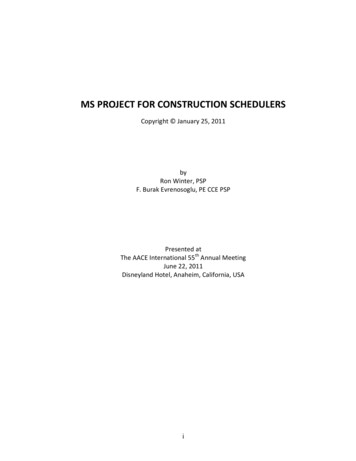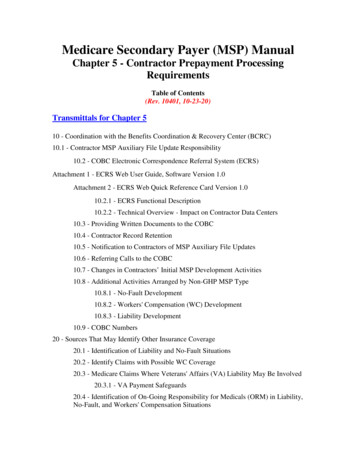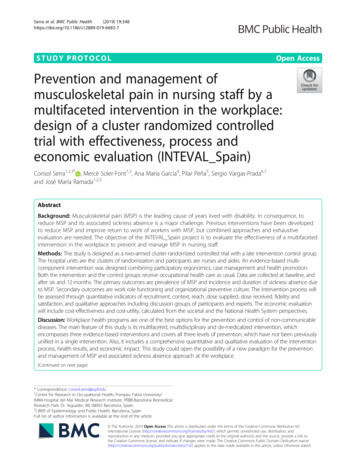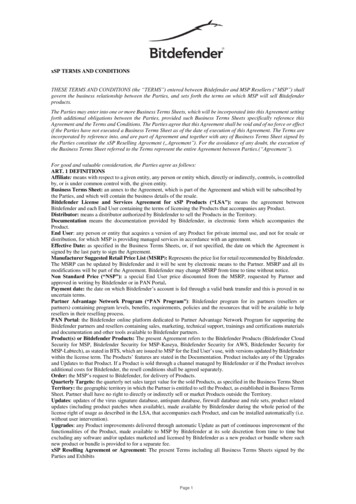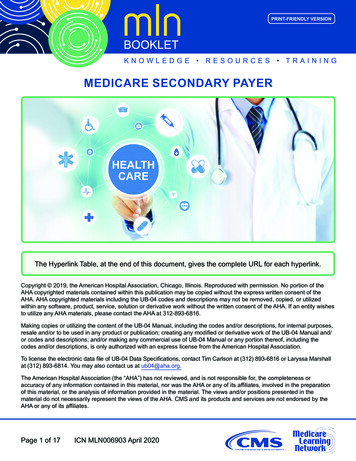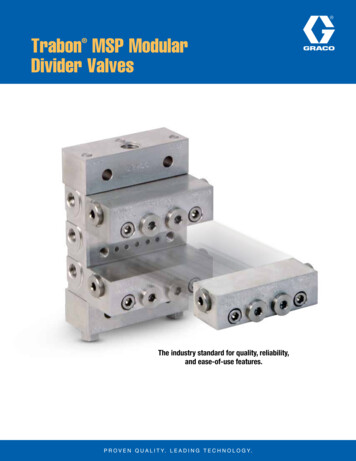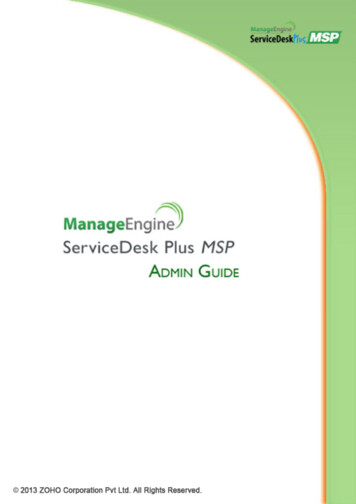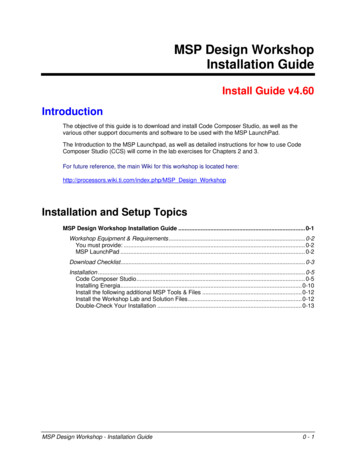
Transcription
GlobalServerMSP Operating SystemEXTENDED SYSTEM ARCHITECTURE, the platform for tomorrowFujitsu's Extended System Architecture (EXA) is thearchitecture that provides optimal performance on large,multiprogramming, multiprocessing computer systems: highend M Series machines.The improvements implemented in EXA greatly increase thecapabilities of Fujitsu's powerful main- frames. EXA supportsup to 2 gigabytes of high-speed system storage, as many as256 channels, and over 4000 1/O devices This advancedtechnology increases speed of data throughput andsignificantly enhances I/O-related performance.The new EXA architecture has been designed to meet thepressing needs for higher speed transaction processing, formore efficient relational databases, and for a high-speedvirtual machine facility.Parallel ProcessingThe system-storage unit links a number of CPU's to provide high-speed communication in asystem-storage-coupled multi-processor (SCMP) system. With exclusive control information insystem-storage, the delays in database and other file access across systems is minimised.System storage also provides "pipe" facilities for files within and between batch jobs. This allowsthe steps of a job or two jobs to execute in parallel, with substantial reduction in the elapsed time.Although a number of clusters may be running, each with its own main storage, CPUs and copyof the operating system, system operation can be carried out on a single system image. Thereneed be no awareness for the operator of physical configuration. Activity in the system as a1
GlobalServerMSP Operating Systemwhole may be balanced to carry out activity on whichever system has the available capacity, andthe user needs no awareness of the existence of multiple clusters.To avoid affecting the performance and responsiveness of online systems, it is still possible toadminister separately, running batch work on separate clusters from online.Fast database accessThe SSU's high-capacity enables a large amount of frequently accessed data to remain residentin the SSU, which can be directly accessed by the CPU. With AIM/DB network and SymfoWARErelational databases located in the SSU, MSP-EX provides an environment for extremely fasttransaction processing. The SSU can substitute for disk storage, providing an area for fastpaging, swapping, and Virtual Input-Output (VIO). The large SSU capacity gives SORT andother MSP-EX functions a high- speed work area for temporary data sets. Of note is the EXCELBATCH solution, based upon the Parallel Data Control Feature (PDCF) software product, whichutilises the SSU to achieve significant reductions in batch processing elapsed time.Failsafe systemsThe EXA architecture and the System Storage Unit combine to give Fujitsu's most powerfulcomputers a new, and unique to Fujitsu, form of multisystem coupling called the System StorageCoupled Multiprocessor (SCMP). The SSU can be shared by as many as eight systems. WithSCMP, multiple system complexes can be configured as hot-standby systems with switchovertimes of seconds. With duplicated SSU, power supply, service processor and all controlhardware, unprecedented levels of failsafe, fault-tolerant operation can be provided.2
GlobalServerMSP Operating SystemAdvanced Virtual Machine/ExtendedThe Advanced Virtual Machine/Extended (AVM/EX) program product for Fujitsu's GlobalServersystems mainframes, combines with the Extended Virtual Machine (EVM) hardware facility toprovide efficient support for the simultaneous use of as many as 14 guest operating systems,each with a minimum of impact on performance.COMPATABILITY with existing investments and futuredevelopmentsThe architecture for the 1990sFujitsu's MSP-EX now offers advanced levels of support for international and industry standards.Applications developed for IBM's MVS environment can be ported to MSP-EX. Direct connectionto other operating systems is possible. Current investments in programs and data have beenprotected, and the ability to use today's and tomorrow's most sophisticated applications hasbeen improved. Cross-vendor compatibility Source code compatibility of high level languages,such as FORTRAN and COBOL, permits applications to be ported from IBM to Fujitsuenvironments. Support for SQL standards provides compatibility with other vendors' relationaldatabases, including IBM's DB2.Multiple system supportAn AVM/EX-equipped system offers users superb adaptability and versatility with advancedmigration and conversion capabilities. Applications developed for IBM MVS can be migrated toMSP-EX via AVM/ EX facilities.'UXP/M is Fujitsu's implementalion of UNIX'UNIX is a registered trademark of UNIX System Laboratories Inc.'IBM is a registered Trademark and MVS is a trademarkof International Business Machines Corporation.INFORMATION SYSTEMS PRODUCTSThe AIM environment for productivityThe Advanced Information Manager (AIM) provides a flexible online data processing3
GlobalServerMSP Operating Systemenvironment, capable of handling large-scale, high-performance information systems. Closelyintegrated with the MSP-EX operating system, AIM Version 20 utilizes the advances built intoMSP-EX and expands the scope of this already versatile production environment.Distributed processingExpanded support for distributed processing and recognized standards is a major enhancementin AIM V20. The Open Systems Interconnection standard for Remote Database Access(OSI/RDA) allows user-transparent access to distributed data. AIM V20 supports a range ofcommunications standards, including FNA and OSI, key components of distributed computing.AIM facilitates distributed computing, both vertically and horizontally, by allowing the integrationof workstations and mainframes from Fujitsu and other vendors. These AIM capabilities, thebasis for cooperative processing, enable user applications to take advantage of thehardware/software strengths of each element in the distributed system.High-volume, network databaseFujitsu's CODASYL network database, AIM/DB, provides for specialized applications that useextremely large databases, or that have high-traffic. AIM/DB offers high speed and highthroughput to such applications.High-speed data accessIn the AIM V20 environment, large transactional tasks are accelerated through sophisticatedhard- ware cooperation. Fujitsu's System Storage Unit (SSU) performs data access atsemiconductor speeds. With SSU, transfer rates for frequently accessed data can be increasedby a factor of 100 compared with DASD.ReliabilityHigh-level integrity and fast recovery of databases and data files are features of AIM V20.Multisystem processing, with shared databases on shared DASD or in the SSU, ensuresoperational continuity. Nonstop processing is achievable with multiple system complexes in hotstandby configurations. Downtime associated with a processor failure is limited to seconds.INTERACTIVE ENVIRONMENT for developmentBenefits to end users and programmersFujitsu's Time Sharing System/Extensions TSS/E) builds upon the advantages of MSP-EX toprovide more efficient access to, and use of, the resources needed for program developmentand system maintenance.TSS/E maintains proven timesharing benefits including: Concurrent access to system resources for many terminal users Transparent user access from any terminal on the network A user-friendly interface and interactive format Improved responsiveness and productivity4
GlobalServerMSP Operating SystemEnhancements through TSS/E and associated products give users improved operationalcapabilities and raised productivity levels. The user interface can be customized to meet theneeds of end users and experienced developers.Associated products that enhance the performance of TSS/E include: the Integrated DataCommunication Manager (IDCM), which simplifies the development of applications for, and theiruse by, workstations in a distributed environment; and the several Application Programenvironment (AP) products, which support interactive operations and facilitate menu and screenmanagement.High levels of security providedFujitsu's Resource Access Control Facility (RACF) protects operating systems, applicationprograms, and databases. RACF meets the C2 level criteria in the "Trusted Computer SystemEvaluation Criteria" defined by the National Computer Security Center (NCSC), part of the USDepartment of Defense (DOD). The security features of RACF are in continuous developmentdue to cooperative efforts between RACF users and Fujitsu designers. The standards of ClassB1 will be met in the near future. RACF maintains control through the following procedures: Auser-ID and a password identify and authenticate each user of the computer system; access toinformation and operations is allowed in accordance with the authorization levels specified foreach user; RACF prevents users from obtaining other users' residual data (ie. data is physicallyoverwritten when deleted by a user, rather than being left accessible on the disk drive as a'residual' dataset); and it maintains detailed audit trails of security-relevant events.GLOBAL NETWORKS and open communicationsThe EXA architecture and the MSP-EX operating system prooide Fujitsu 's powerful computerswith network facilities capable of handling every high-volume, large-scale distributed processing.Conformance to OSI, CCITT, ANSI and SNA standards ensures high levels of connectivity.Expansive global networks, with trillions of connected computers and workstations, are possible.Facilities supported by the network enable efficient dissemination of information by voice, textand image throughout the organization and the world.Wide range of protocols supportedSupport for widely used protocols is provided with MSP-EX's enhanced Fujitsu NetworkArchitecture, FNA5. TCP/IP, and Open Systems Interconnection (OSI) protocols open avenuesto a wide range of industry-proven applications.Peer-to-peer communicationsFNA5 allows peer-to-peer communications in which data transfer is based upon internationalstandards, which eliminate the need for translation software. FNA5 supports intelligent networkswith functions that enable dynamic adaptation to changes in network topology.Expandable, high-speed networksThe Extended and Open Networking Facility (EONF) is Fujitsu's array of software and hardwareenhancements that enable FNA5 networking. EONF, based on OSI standards, supports bothOSI and current FNA protocols on the same communication lines. With EONF's support fortrillions of addresses through the Virtual Telecommunications Access Method-G (V/TAM-G) V30,5
GlobalServerMSP Operating Systemnetworks of virtually unlimited size are possible. Support for Integrated Services Digital Network(ISDN), which permits simultaneous transmission of digital voice, computer, and video signalsover public telephone lines, is provided by EONF VTAM-G V30 also enables use of high-speedFiber Distributed Data Interface (FDDI) LANs, which can communicate at 100 megabits persecond. FDDI is an emerging ANSI/ISO standard for the use of fiber optics in networks.Integrated communication interfaceFujitsu's Integrated Data Communication Manager (IDCM) integrates the communicationinterfaces of the AIM, TSS and Distributed System Manager (DSM) environments and allowsusers to develop applications that are independent of network architecture. IDCM interacts withVTAM-G V30 to create a unified communication interface for users of workstations.COMPONENTS optimized for performanceThe major new components of Fujitsu 's EXA architecture and of the MSP-EX operating systemcooperate to deliver significant benefits to Fujitsu S top-performing mainframes. EXA has beendesigned around the concept of using a mainframe as a GlobalServer Fujitsu 's GlobalServerincorporates the functions of a high-speed process server a data server; a network server; andof systems management.High-throughput process serverThe elements of EXA that combine to allow quick access and high throughput of system datainclude: The System Storage Unit (SSU), a new level of semiconductor storage, which facilitates high-speed, highvolume transaction processing. The SSU has an extremely fast data-transfer rate of up to 500 megabytesper second, and a capacity of up to 8 gigabytes. It is directly accessible from the CPU and enables datasharing and communication among systems. As many as four systems can be connected. The 47-bitaddressing capability of the SSU allows a maxi- mum logical space of 128 terabytes. A multi-cluster configuration allows a number of MSP-EX systems to share System Storage. These systemscan share files, including database and log files, in the very-fast access System Storage area. Such a multicluster system also allows the use of SSU features to configure a hot-standby system, which is capable ofswitching processing from a failed system to a working system in a matter of seconds.6
GlobalServerMSP Operating System The Extended Virtual Machine Facility (EVM), an EXA firm- ware feature, which incorporates the controlinstructions for many of the functions vital to efficient virtual computing. These instructions, formerlysimulated by software, control I/O operations as well as communications between multi- processor CPUs.EVM, available for Fujitsu's M-760, M-780 and M-1800 mainframes, provides for significant reduction insystem overheads. The Advanced Virtual Machine/Extended (AVM/EX) facility, the software product that combines with EVM togive Fujitsu's high-end machines the ability to run up to 14 operating systems simultaneously and with highperformance. Both Fujitsu and IBM operating systems can run under AVM/EX, with a minimum of impact onperformance. AVM/EX supports shared CPUs, up to 256 shared channels, and flexible use of the SSU. The Extended Channel Facility (ECF), which enables I/O requests to be completed via any free pathconnected to that channel. This dynamic path reconnection considerably increases channel load capacity.ECF is a firmware facility which resides in the channel subsystem and thereby reduces CPU overhead. ECFextends the number of available channels to 256, and the number of connectable I/O devices to over 4000. The use of faster optical channels has improved I/O transfer rates and throughput. OCLINK (OpticalChannel LINK) channels, together with the new CKD/EX channel protocol, further improve data throughputand reliability. They provide higher speed channel transfer (12-19MB/sec); fewer channels required withmuch higher channel throughput and loading (50-70% busy possible); continuous operation in the event offailure; active maintenance while links in use; and remote peripherals - up to 9Km distance from the centralsite.7
GlobalServerMSP Operating SystemEnhanced data serverMSP-EX's data server capabilities are derived from integrated components that enable highspeed network and relational database processing, and improved distributed computing. Themajor data server products include: The Relational Database II (RDB II), Fujitsu's second generation relational database, which conforms toSQL and RDA international standards. RDB II takes advantage of EXA enhancements to provide significantimprovements in response time and throughput. RDB II is the base for both decision-support andtransaction processing systems in the 1990s. The Advanced Information Manager V20 (AIM V20), a pro- gram product that supports very large-scale andhigh-traffic information processing tasks in the transaction-processing environment. AIM supportsdistributed processing, both horizontally between mainframes and vertically between the mainframe andworkstations. Standard communication protocols enable AIM to operate in multi-vendor environments. AIMconforms to OSI international standards, which allow operations in a variety of environments. The AIM/DB network database, which offers high- performance in ultra large-scale transaction processingenvironments. When resident in the SSU, the database has extremely fast accessibility. EXA's advancedhot- standby facilities ensure high availability for AIM/DB. The Advanced Information Manager Bridge (AIM/BRIDGE), which allows major ISV's software developedunder IBM's CICS environment to run in Fujitsu's AIM environment. The Integrated Data Communication Manager (IDCM), which integrates the communication interfaces of theAIM, Time Sharing System (TSS), and Distributed System Manager (DSM) environments. The Strategic Interactive Information System (STRACT), an application designed to unify database accessby providing one set of commands for access to various databases including RDB II, AIM/DB, VSAM, andSAM. STRACT also offers services for database processing including graph and report creation, and timeseries forecasting. MANASYS, the latest enhancement to Fujitsu's fourth generation language, used with the AIM onlinerelational and network databases, as well as with AIM's transaction processing subsystem. MANASYSimplements a programmer workbench facility that provides options for two new products: MANAGEN, anautomatic application generator, and MANAREF a cross reference and impact analysis tool.8
GlobalServerMSP Operating System The Application Development And Management facilities/ Information Resource Dictionary (ADAM/IRD), aprogram product for managing resources in the application development environment. ADAM/IRDcoordinates use of information related to data items, records, screens, reports, and programs, stored in theADAM/IRD dictionary. The developer can easily catalogue, update, delete, and retrieve such informationfrom the dictionary.High-capacity network serverFujitsu's Networking Architecture, FNA5, offers major enhancements to MSP-EX networks.MSP-EX network facilities greatly increase MSP connectivity and expand support for remotesystems. Among the most significant of the new network products are: The TCP/IP Support Program (TISP), which supports the TCP/IP protocol under MSP This support allowsinterconnection of MSP and UNIX environments. With TISP, the MSP host is able to act as a server for filestorage, mail systems, file transfer, and applications for connected UNIX-based systems. The FNA Loose Coupling Facility (FLCF), which enables connection to IBM's SNA networks. FLCF forms agateway on the stable, physical unit type 2 interface, and is thus independent of the version and level ofIBM software. The Virtual Telecommunications Access Method-G V30 (VTAM-G V30), which adopts the OSI standardnetwork address method and greatly expands the number of connectable computers and workstations.VTAM-G V30, in cooperation with FLCF and TISP, links directly to IBM's SNA, and to UNIX systems.Advanced system managementMSP-EX provides for the integration of security and of system management facilities. Thissophisticated integration increases both the security and the efficiency levels available to thecomputer system. The system management products include: The Resource Access Control Facility (RACF), which provides improved security for systems programs,application programs, and databases. RACF currently meets the standards of Class C2 and it is intended tomeet the standards of Class B1. The Archives Service Program (ARCS), which includes functions that backup, restore, copy, and migratedata on DASD volumes. The Automatic Data Migration Facility (ADF), which manages use of secondary storage, such as DASD andcartridge tape libraries. The Library Support Program (LIBSP), which enables automatic control of the operations of optical diskstorage libraries and of cartridge tape libraries. The Advanced Printing Subsystem (APS), which offers a single system interface for message and formsprocessing within batch, time-sharing, and AIM environments. The Disk Space Control Facility (DSCF), which works with RACF to control the disk space available toindividual users or groups. DSCF also restricts access to specified disks. Various other MSP-EX facilities, which provide for integrated network monitoring and management, and fordynamic updates of host, network, and workstation environments.9
GlobalServerMSP Operating SystemEfficient systems softwareThe systems software for MSP-EX enables dramatic improvement in system efficiency. Theenhanced systems programs include: The SORT function, which has been enhanced to take advantage of EXA's high-speed SSU and 31-bitaddressing capabilities. High-level languages, such as COBOL 85, can call SORT from the extended area.Efficient use of the extended area provides significant reductions in I/O operations. TSS/E, an extension to MSP's Time Sharing System, which provides users with better facilities.Improvements have been made to logon procedures, space management, data set retrieval, and commandprocessing. The enhanced functions include syntax customization. The Virtual Directory Facility (VDF), which allows the directory section of a partitioned data set to reside invirtual storage VDF substantially increases the speed of directory reads and also decreases the number ofI/O operations.Wide range of applications and languagesFujitsu's MSP-EX operating system supports a huge range of applications and advancedversions of the major programming languages, including COBOL 85, FORTRAN 77, PL/I, and Camong others. MSP-EX's high degree of compatibility with the IBM MVS environment allows useof a large number of proven products. Some applications and programming languages areavailable in a range of the world's languages: English, Japanese, Korean, Taiwan Chinese, andChinese.10
MSP Operating System 1 EXTENDED SYSTEM ARCHITECTURE, the platform for tomorrow Fujitsu's Extended System Architecture (EXA) is the . Support for widely used protocols is provided with MSP-EX's enhanced Fujitsu Network Architecture, FNA5. TCP/IP, and Open Systems Interconnection (OSI) protocols open avenues to a wide range of industry-proven .

